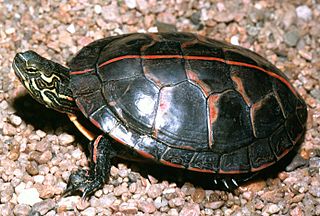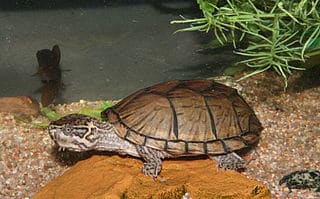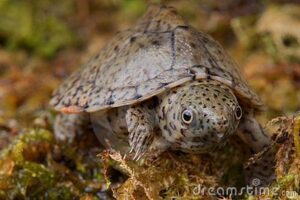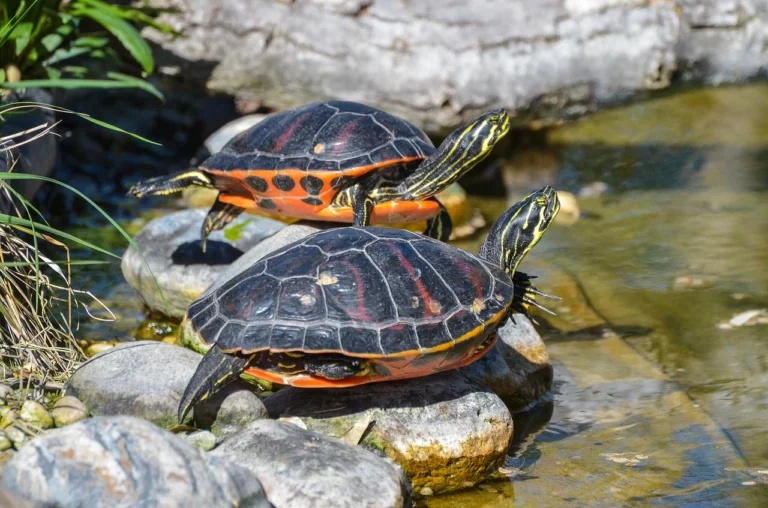So, finally, you have decided to own a turtle as a pet. Congratulations!
Turtles are easy-going, less demanding in nature, rarely fall sick, and live pretty LOOOOOOONG. That’s why, across the globe, turtles are a popular pet, and its popularity is reaching new height every day. During these days of social distancing and pandemic, petting a turtle at home can help you relieve stress and feel happy.
But which types of pet turtle is your favorite?
If you haven’t fixed your mind on a specific turtle breed, this article will be a BIG HELP for you. Today, we will discuss ten common pet turtle types, which you will easily find at pet stores and won’t require spending huge on them.
The discussion will include their caring requirements, common characteristics, and distinctive features. So, if you are seeking to get the right turtle, this is your one-lifetime chance.
Ten Popular Types of Pet Turtle That You Would Want at Home
Owning a turtle is a long term and challenging promise since most will outlive you. Also, turtles are available in different sizes, colors, and they differ highly when it comes to aggressiveness and so on. Some are friendly, making them great for pets, while others are very aggressive and less perfect for household petting.
Also, diet, space, and caring requirements vary prominently from species to species. We have included mostly the easy-going and famous turtle types to kick start your turtle petting life with a BANG.
Red Eared Slider:

The red-eared slider is ardently by far the most widespread turtle species around the globe. It is an aquatic turtle and is friendlier compared to most turtle types.
What’s more, this turtle is friendly too, and is most likely to engage with your kids. You will find the red-eared slider in almost every pet shop and also widely available in the wilderness. It is pretty active and is mainly kept in small tanks inside the house.
Nonetheless, if you can maintain UV lights, proper water temperature, and basking spot, red-eared slider also makes a great outdoor pet in ponds. Many expert turtle owners recommend that before introducing the turtles in the outside pond, keep them inside and slowly make them familiar with the external environment.
Ideally speaking, red-eared sliders have a specific dietary and need special care. This requirement can, at times, make the red-eared slider caring extremely expensive and challenging. So, be aware of such inconveniences. Last but not least, with proper diet, care, and maintenance, this turtle has a life expectancy of about 50 years.
They have a lots of similarities with the painted turtle.
Quick Overview:
- Known as: Red-eared slider, water slider, red-eared terrapin, and many more.
- Scientific name: Trachemys Scripta Elegans
- Size: Around 10-12 inches
- Expected lifetime: 25 years to 35 years
- Pet experience stage: Intermediate
- Tank Requirements: 10 gallons to 20 gallons.
- Diet: Small fish, snails, krill, shrimp, and vegetables.
Eastern Box Turtle:

Eastern box turtles are mainly outdoor species and require ample spacing for pets. What’s make them a great pet is their easy-going attitude and less demanding care and maintenance.
These turtles are highly adaptable in every condition and can be put both indoor and outdoor (mainly) with proper care. The eastern box turtle prefers a humid situation and thrives in shallow water. However, they will also need UV lighting and basking spot both indoor and outdoor as well as a moist substrate for a healthy tank.
Since eastern box turtles love high-humidity, they feel discomfort in both dry and cold weather. If the weather is ardently too dry or too cold, the turtle can catch severe respiratory infections. And this can be lethal for them, so keep an eye on it.
This turtle type is a bit shy, which makes it hard to see generally. Additionally, they are mostly non-aggressive, and if they interacted gently, they would start liking you. Hence, you can help them showcase their real personality with gentle handling.
And at best, if you have the right treat in your hand, they will even greet you with a stretched neck with head out and mouth open.
Quick Overview:
- Known as: Easter box turtle and land turtle
- Scientific name: Terrapene Carolina Carolina
- Size: 5 inches to 7 inches
- Expected lifetime: 100 years in wild and 25 to 45 years in captivity.
- Pet experience stage: Beginner
- Tank Requirements: 20 gallons to 25 gallons of water.
- Diet: Vegetables, shrimps, small fish, and live insects
Yellow-Bellied Slider:

Perhaps the most attractive of all pet turtles and also active, the yellow-bellied turtle is the true sweetheart of most turtle lovers. They remain hyperactive during the daytime and are not as shy as the eastern box turtles.
Hence, turtle owners love observing the beautiful creature and watch their overloaded cuteness. Also, it is hardy, meaning these are less vulnerable against diseases given the right UV lighting and diet.
If you keep them inside, the tank needs to be bigger, not because they grow giant but because they low swimming in the water. Similarly, their outdoor enclosure also needs to be significant. You will find them widely in pet stores, thanks to their immense popularity. However, we still suggest you to source the yellow-bellied slider from a reputable and trustworthy pet store.
Their hyperactivity in the enclosure is a treat to eyes and, over time, makes excellent intimacy with their owners. Also, they tend to be non-aggressive too.
Quick Overview:
- Known as: Yellow-bellied slider or yellow slider
- Scientific name: Trachemys Scripta Scripta
- Size: Females grow around 8 inches to 13 inches while males grow about 5 inches to 9 inches.
- Expected lifetime: In captivity, they will live up to 40-45 years.
- Pet experience stage: Beginner and intermediate
- Tank Requirements: 20 gallons to 30 gallons of water.
- Diet: Vegetables, small fish, and live insects.
African Sideneck Turtle:

If you look closely, at times, African sideneck turtles may seem to have a smiling face, claims many owners. Although the fact is yet to be judged, the unique shape of the fully retracted neck makes the sideneck turtle so popular.
Their shell is similar to a land turtle, but they are aquatic in nature, and such distinctions set the African sideneck turtle apart from others. The turtle is a popular pet choice thanks to its unique appearance, features, and size.
Nonetheless, the African sideneck turtle is exceptionally demanding when it comes to caring and tank management. Firstly, they require a massive tank, often exceeding 75 gallons. Also, you need to remove the tank water frequently to prevent the build-up of bacterial and wastage colony.
You can equip a quality biological and mechanical filter to get rid of the stress of removing water so frequently. Likewise, every turtle, they also need proper UV lighting and basking spot. You must ensure that the temperature remains above 70°F always.
Because of the necessity of such temperature management, it is wise to pet them indoor mostly.
Quick Overview:
- Known as: African aquatic sideneck turtle, African sideneck turtle, and helmeted turtle.
- Scientific name: Pelomedusa subrufa
- Size: They grow around 6 inches to 9 inches.
- Expected lifetime: In captivity, they will live up to 50 years or more.
- Pet experience stage: Beginner and intermediate
- Tank Requirements: 50 gallons to 75 gallons.
- Diet: Vegetables, chicken, small fish, and live insects.
Painted Turtle:

Painted turtle, perhaps, has the widest variety of subspecies around the world with four widespread subspecies. These subspecies are western painted turtle, eastern painted turtle, midland painted turtle, and southern painted turtle.
The subspecies name originated from their specific location. However, the most popular of these four species is the western painted turtle.
With detailed and apparent shell markings and yellow lines on the body, western painted turtle brings eye-catchy appeal to its owners. Also, their distinctive appearance and non-aggressive character make them a perfect home pet.
However, they demand commitment with an expected life expectancy over 50 years in captivity, given proper care and diet. Since these are aquatic turtle and loves swimming in shallow water, their tank requirement, both indoor and outdoor, is immense.
Also, they love eating live fishes as they swim in the water. However, their shy nature makes them hard to find during daytime and are less responsive to handling- better not disturb them.
Quick Overview:
- Known as: Painted turtle and western painted turtle.
- Scientific name: Chrysemys picta bellii
- Size: An adult will grow between 8-1o inches.
- Expected lifetime: They live up to 50 years and sometimes a few years more.
- Pet experience stage: Beginner
- Tank Requirements: 15 gallons to 25 gallons.
- Diet: Vegetables, live insects, and other sources of protein.
Common Musk Turtle:
 When felt threatened, common musk turtle will release a somewhat musty and foul odor that keeps their predators away. Due to such stinky smell discharging capacity, these are also known as ‘stinkpot.’
When felt threatened, common musk turtle will release a somewhat musty and foul odor that keeps their predators away. Due to such stinky smell discharging capacity, these are also known as ‘stinkpot.’
However, they are luckily less demanding when it comes to care and maintenance. That’s why the common musk turtle is a perfect turtle type to begin your petting career. Also, their small size and rather shy nature mean they will more likely occupy less space in water tanks. It means you can keep multiple turtles in the same nest.
Also, they are weak swimmers and so require shallow water for better survival. Last but not least, it demands massive UV lighting and basking spot to regulate their body temperature to prevent hypothermia and respiratory diseases.
Quick Overview:
- Known as: Stinkpot, eastern musk turtle, and common musk turtle.
- Scientific name: Sternotherus Odoratus
- Size: They have a small measure of 4-6 inches only.
- Expected lifetime: They live up to 40-50 years.
- Pet experience stage: Beginner
- Tank Requirements: 15 gallons to 20 gallons.
- Diet: Green leaves, live insects, and small fishes.
Razor-backed Musk Turtles:

If you want a display turtle at home to showcase their beauty, razor-backed musk turtles will be a great pet at home. However, they are the biggest among all musk turtles, although they will grow as large as 6 inches only.
They are prominently easy to care for and are carnivorous. So, forget about green leaves while preparing their diet. Since they are small in size, their tank size also doesn’t require to be significant. However, a bigger tank means they will feel less stressed and love the nest.
However, they are timid and so don’t like handling. Furthermore, they take a long time to get familiar and comfortable with a new environment th�t can, at times, be a painful wait for owners.
Quick Overview:
- Known as: Razor-back musk turtle.
- Scientific name: Sternotherus carinatus
- Size: 4-6 inches only.
- Expected lifetime: They have moderate 25-30 years of life expectancy.
- Pet experience stage: Beginner
- Tank Requirements: 20 gallons to 30 gallons.
- Diet: Worms, fishes, insects, and shrimps.
False Map Turtle:

If you look closely at the turtle body, you will discover visible lines running down across their body all over. Also, their shells have contour lines, and that’s why they take the name false map turtle. It is a common aquatic turtle in northern America and is widely found.
Its shell has a raised back that resembles a saw and features impressive contour lines. All these make it a gorgeous pet to display in tanks. The size difference ardently between male and female is also very prominent.
While a male will strive in 20-30 gallons of water, the female ones will need 75 gallons of tank water for successful survival. Apart from the tank requirements, you will hardly find any turtle type as easy to take care of this.
Quick Overview:
- Known as: False map turtle
- Scientific name: Graptemys pseudogeographica pseudogeographica
- Size: Males grow 4-6 inches, but females are much bigger at 8-10 inches.
- Expected lifetime: They have a moderate 33 years of lifetime.
- Pet experience stage: Beginner
- Tank Requirements: 20-30 gallons for males and 75 gallons for females.
- Diet: Worms, fishes, insects and shrimps and veggies.
Mississippi Map Turtle:

It is a poular subspecies of the false map turtle but has a distinctive body feature. They have a high dorsal fin that runs across their entire shell. Due to their raised dorsal fin, many people also call them ‘Sawback turtle.’
They have a similar small size as the false map turtle and so, is a popular pet choice among turtle lovers. What’s more, they are very hardy against diseases and so need less care. However, the Mississippi map turtle is scary about people.
So, be extra attentive as you handle them. The only ardent downside is that they live only around 25-30 years. But it can be a blessing also since it means less commitment compared to many other types of pet turtles.
Quick Overview:
- Known as: Sawback turtle and Mississippi map turtle.
- Scientific name: Graptemys pseudogeographica kohni
- Size: Males grow 3-5 inches, but females are much bigger at 8-10 inches.
- Expected lifetime: They have 25-30 years of life.
- Pet experience stage: Beginner
- Tank Requirements: 20-30 gallons for males and 75 gallons for females.
- Diet: Fish, shrimp, chicken, vegetables and so on.
Spotted Turtle:

The last recommendation for popular pet turtles type in our list is a beautiful and elegant spotted turtle. They have a greenish shell with yellow spots from where they draw their famous name.
Furthermore, they are smaller, even among the little turtles, which make them the right choice if you lack ample spacing at home to keep a giant turtle. They don’t ask for a deeper water level due to their week swimming capacity.
These turtles are less demanding. But a proper diet with plenty of meats is crucial for their health too.
Quick Overview:
- Known as: Spotted turtle and Clemmy.
- Scientific name: Clemmys guttata
- Size: They will grow up to 4-6 inches
- Expected lifetime: They have 50 years of a lifetime, although some are recorded to live above 100 years even.
- Pet experience stage: Beginner
- Tank Requirements: 20-30 gallons.
- Diet: Fish, shrimp, chicken, and green leaves.
The Wrapping Up
So, these out top ten recommendations for popular, easy-going, and less demanding types of pet turtles. We have selected the turtles from a wide variety and so, will be ideal for everyone.
You can pick the spotted turtle, Mississippi map turtle, and razor-back musk turtle for display purpose. And yellow-bellied turtle and red-eared slider turtle are for those who love handling their turtle frequently.
So, please make your selection wisely and consider their water requirement, caring necessity, and dietary chart before you make the final selection. Good luck.






